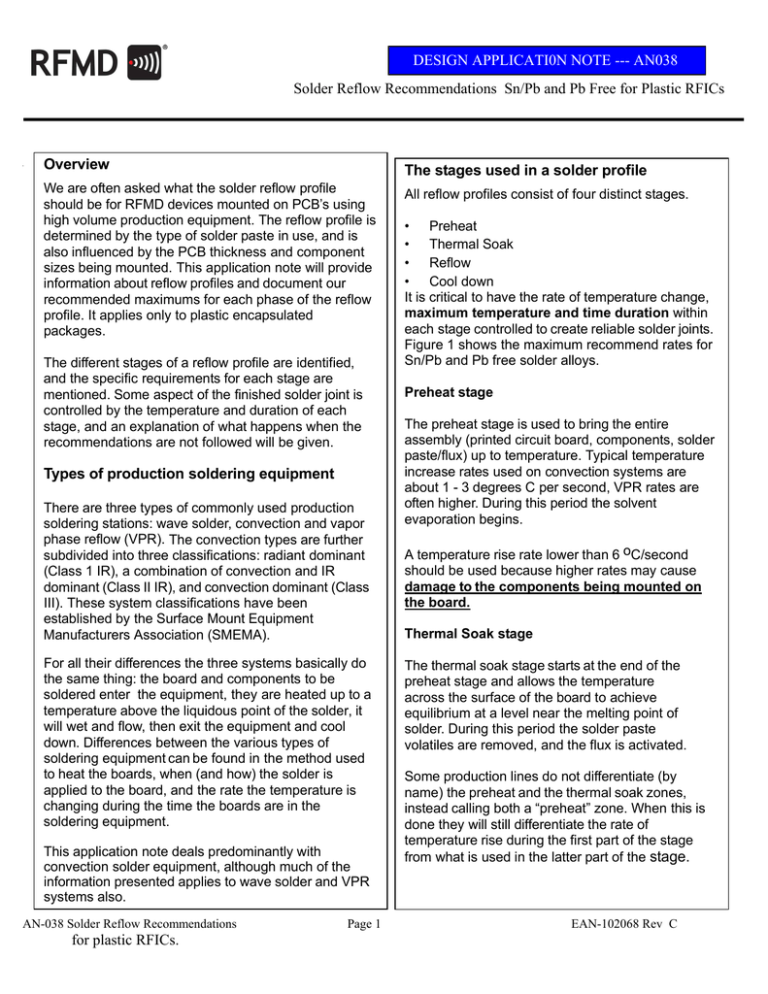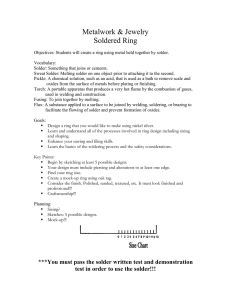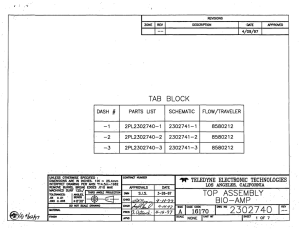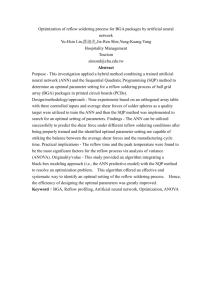Solder Reflow Recommendations Sn/Pb and Pb
advertisement

DESIGN APPLICATI0N NOTE --- AN038 Solder Reflow Recommendations Sn/Pb and Pb Free for Plastic RFICs Overview The stages used in a solder profile We are often asked what the solder reflow profile should be for RFMD devices mounted on PCB’s using high volume production equipment. The reflow profile is determined by the type of solder paste in use, and is also influenced by the PCB thickness and component sizes being mounted. This application note will provide information about reflow profiles and document our recommended maximums for each phase of the reflow profile. It applies only to plastic encapsulated packages. All reflow profiles consist of four distinct stages. The different stages of a reflow profile are identified, and the specific requirements for each stage are mentioned. Some aspect of the finished solder joint is controlled by the temperature and duration of each stage, and an explanation of what happens when the recommendations are not followed will be given. Types of production soldering equipment There are three types of commonly used production soldering stations: wave solder, convection and vapor phase reflow (VPR). The convection types are further subdivided into three classifications: radiant dominant (Class 1 IR), a combination of convection and IR dominant (Class II IR), and convection dominant (Class III). These system classifications have been established by the Surface Mount Equipment Manufacturers Association (SMEMA). For all their differences the three systems basically do the same thing: the board and components to be soldered enter the equipment, they are heated up to a temperature above the liquidous point of the solder, it will wet and flow, then exit the equipment and cool down. Differences between the various types of soldering equipment can be found in the method used to heat the boards, when (and how) the solder is applied to the board, and the rate the temperature is changing during the time the boards are in the soldering equipment. This application note deals predominantly with convection solder equipment, although much of the information presented applies to wave solder and VPR systems also. AN-038 Solder Reflow Recommendations for plastic RFICs. Page 1 • Preheat • Thermal Soak • Reflow • Cool down It is critical to have the rate of temperature change, maximum temperature and time duration within each stage controlled to create reliable solder joints. Figure 1 shows the maximum recommend rates for Sn/Pb and Pb free solder alloys. Preheat stage The preheat stage is used to bring the entire assembly (printed circuit board, components, solder paste/flux) up to temperature. Typical temperature increase rates used on convection systems are about 1 - 3 degrees C per second, VPR rates are often higher. During this period the solvent evaporation begins. A temperature rise rate lower than 6 oC/second should be used because higher rates may cause damage to the components being mounted on the board. Thermal Soak stage The thermal soak stage starts at the end of the preheat stage and allows the temperature across the surface of the board to achieve equilibrium at a level near the melting point of solder. During this period the solder paste volatiles are removed, and the flux is activated. Some production lines do not differentiate (by name) the preheat and the thermal soak zones, instead calling both a “preheat” zone. When this is done they will still differentiate the rate of temperature rise during the first part of the stage from what is used in the latter part of the stage. EAN-102068 Rev C We consider them as two separate stages. The rate of temperature rise in the thermal soak stage is often reduced to less than 1 oC per second, and is typically around 0.5 oC per second. If the temperature is allowed to get too hot in the soak zone, the solder paste will oxidize and solder balls will form. A thermal soak period of not more than 120 seconds max is recommended, during which the temperature can rise up to (but should not exceed) +180oC. REFLOW STAGE The reflow stage is the time period where the solder changes from a solid to a liquid, and will flow in the areas where solder paste has been applied and solder mask is not present. The rate of temperature change increases rapidly to a specified level, then the PCB has a dwell time at the specified temperature where the flux action occurs and good wetting is obtained. After remaining at the specified temperature the heat is removed and the cool-down stage is started. During the reflow stage temperature control is critical. If the temperature is too low cold solder joints may form with a dull or grainy appearance. If the temperature is too high component damage, PCB charring, or discoloration may occur. Extended time above the reflow temperature can cause the formation of intermetallic growth, leading to potentially weak and brittle solder joints. Specifying and controlling the maximum temperature is difficult. The component temperature that is reached during the reflow stage is determined not only by the temperature of the equipment chamber and the associated dwell time, but also by the package volume and whether the component is surface mount or through hole. The maximum temperature used is dependent on the component mix being soldered to the PCB. Refer to figure for RFMD recommend maximum times and temperatures for each zone. Cool Down stage This is the final stage, and refers to the period after reflow where the temperature is decreasing and is below the solder liquidous once again. The solder grain size and fatigue resistance of the joint is controlled by the rate the AN-038 Solder Reflow Recommendations for plastic RFICs. temperature drops, and generally you would like to cool the PCB down as quickly as possible. Fans are usually used to circulate cooler ambient air around the PCB. Verification that the fans are operating and providing cooler ambient air flowing over the surface of the PCB is generally all that is required during the cool-down phase. Cool down rate should not exceed 10oC/second. Recommendations The high temperatures that devices are subjected to during solder reflow can cause the vapor pressure of moisture inside the package to increase rapidly. This vapor pressure may cause numerous internal problems (reference JEDEC JSTD-020A section 3) which may (or may not) be immediately obvious. For this reason it is recommended that a “pre-bake” be done on devices prior to reflow, if the components are NOT rated as MSL 1, for the peak temperature being utilized. Recommending a universal profile that will work in all cases is not a realistic goal. Boards fabricated with a mixture of large and small device packages require different profiles from those board built with either all large, or all small devices. As a general rule of thumb the maximum temperature in the reflow stage needs to be higher if larger packages are being used. The solder paste manufacturers guidelines for the particular paste in use should be used as a starting point for determining the time and temperature used in the four stages of the profile. The recommendations should then be compared to the maximums specified in this document, and altered to ensure that our maximum specifications are not exceeded. Compatibility with Pb Free Solder reflow profiles RFMD does not recommend soldering our devices which are not classified as green and Pb free at the higher temperature profiles required for Pb free alloys. Devices with Pb free plating, that are compatible with the Pb free reflow profiles, will be identified by the addition of “Z” to the end of the standard part number. Add the “Z” to the basic part number when ordering. Pb free parts are compatible with Sn/Pb reflow solder profiles and practices. Page 2 EAN-102068 Rev C Figure 1 – Max Reflow Recommendations AN-038 Solder Reflow Recommendations for plastic RFICs. Page 3 EAN-102068 Rev C



